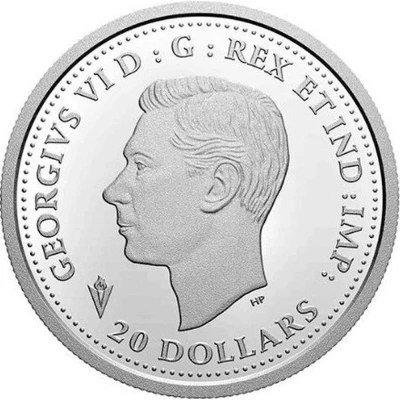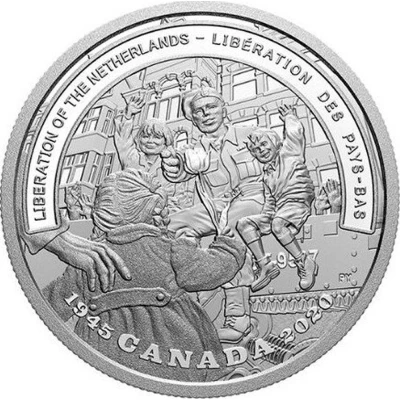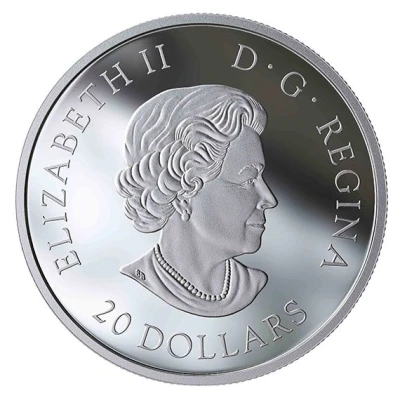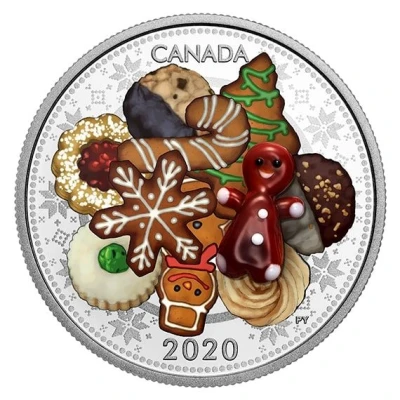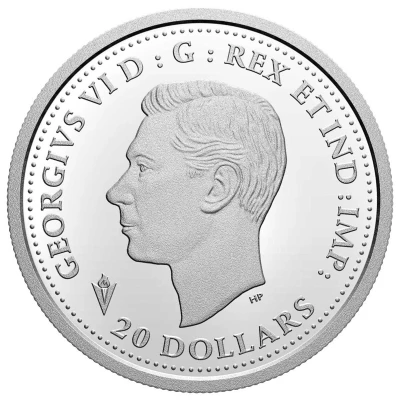
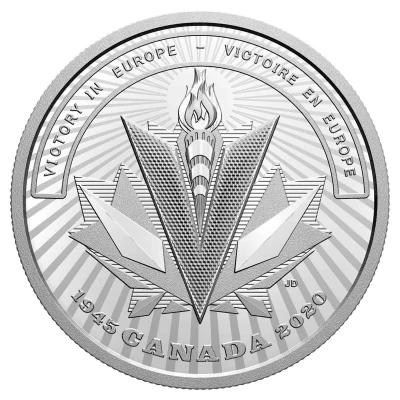

20 Dollars In the name of George VI; Victory in Europe
2020 year| Silver (.9999) | 31.39 g | 38 mm |
| Issuer | Canada |
|---|---|
| Queen | Elizabeth II (1952-2022) |
| Type | Non-circulating coin |
| Year | 2020 |
| Value | 20 Dollars 20 CAD = USD 15 |
| Currency | Dollar (1858-date) |
| Composition | Silver (.9999) |
| Weight | 31.39 g |
| Diameter | 38 mm |
| Shape | Round |
| Technique | Milled |
| Orientation | Medal alignment ↑↑ |
| Updated | 2024-10-04 |
| Numista | N#349161 |
|---|---|
| Rarity index | 97% |
Reverse
Set against a sunburst, the reverse design by Canadian artist Jamie Desrochers offers a modern take on the 1943-45 Victory Nickel designed by Thomas Shingles. The original "V" for Victory and the torch symbol of sacrifice have been updated to represent the new generations who are carrying the torch of remembrance on the 75th anniversary of the end of the Second World War ("1945" and "2020"). The two maple leaves from the wartime coin play a larger role in this design, where a large maple leaf in the background subtly unifies the maple leaf-shaped arrangement of geometric shapes. The forms represent different peoples, races, cultures and the varied backgrounds of the men and women who contributed to the Allied victory in 1945.
Script: Latin
Lettering:
VICTORY IN EUROPE - VICTOIRE EN EUROPE
JD
1945 CANADA 2020
Designer: Jamie Desrochers
Edge
Serrated
Comment
"We win when we work willingly."Our Second World War: Battlefront series ends with a special tribute to all the Canadians and Newfoundlanders who fought on the battlefronts of the world, and to those who supported their efforts from the homefront. Victory requires sacrifices of many kinds, and that's what this intricately engraved design represents. The bold "V" and the flaming torch from the 1943-45 Victory Nickel are echoes of our past and express a desire to never forget. Completing the maple leaf-shaped arrangement are the geometric forms that represent the different backgrounds (cultural, ethnic, linguistic) of the men and women who served, as well as their contributions to victory 75 years ago.
"This coin gives you the best our engraving techniques have to offer today. With its symbolic torch, the Victory Nickel is one of our most recognizable commemorative circulation coins. I decided to take its statement literally, and create a legacy of remembrance that can be passed on to the next generation. My hope is that future generations will pick up the torch that was handed down byThomas Shingles and entrusted to me for this brief moment, and that they will someday make it their own." Jamie Desrochers:Artist
A generation's legacy:
They patrolled our coastline, defended the skies over theUnited Kingdom and fought advancing enemy forces in the Pacific.
They took the harsh lessons learned at Dieppe and applied them successfully to the landings in Normandy. They were the faces of freedom as they pushed into Occupied Europe – first in Sicily and Italy, then in Northwest Europe. And they never ceased their efforts to protect vital supply routes from the deadly U-boat menace.
From its tombac composition to the way it was engraved, the Victory nickel is a window to an era in which the war effort impacted every aspect of society in Canada and in Newfoundland, which became Canada's tenth province in 1949.
Today, the generation that served in the Second World War is passing the torch of remembrance to new generations of Canadians. To express our gratitude for the sacrifices and achievements of the Greatest Generation, we've taken up the torch passed down by one of our own (engraver Thomas Shingles) and we're rekindling it once more on this final Battlefront coin. Their legacy, forever preserved on our coins, will not be dimmed with time.
Did you know…
On May 5, 1945, General Foulkes of I Canadian Corps accepted the formal surrender of German troops in Wagenigen, Netherlands, while Lieutenant-General Guy Simonds of II Canadian Corps accepted the surrender at Bad Zwischenahn, in northern Germany. Two days later, on May 7, the formal military surrender agreement was signed in Rheims, France, and the war in Europe was over.
On V-E Day (May 8, 1945), Canada had one of the largest navies, the fourth largest air force and an army with six divisions. Out of a population of 11 million people, more than a million Canadians and Newfoundlanders donned a military uniform between 1939 and 1945.
Nickel was among the first metals allocated to the Allied war effort – that's why the 1943 Victory nickel,which introduced the "V for Victory" design that inspired this coin, was made from a copper-zinc alloy known as tombac. A key component of stainless steel, nickel was essential for manufacturing armour plates, vehicles, weapons, ammunition, and even components of the Bailey bridges built by Royal Canadian Engineers in 1944 and 1945. It's just one example of how efforts on the home front supported Canada's efforts on the battlefront, from beginning to end.
Interesting fact
One interesting fact about this coin is that it commemorates the 75th anniversary of the end of World War II in Europe, which is reflected in its name "Victory in Europe."
Price
| Date | Mintage | VG | F | VF | XF | AU | UNC |
|---|---|---|---|---|---|---|---|
| 2020 | 7500 | - | - | - | - | - | - |
Values in the table are based on evaluations by sales realized on Internet platforms. They serve as an indication only for 20 Dollars (In the name of George VI; Victory in Europe) 2020 coin.
